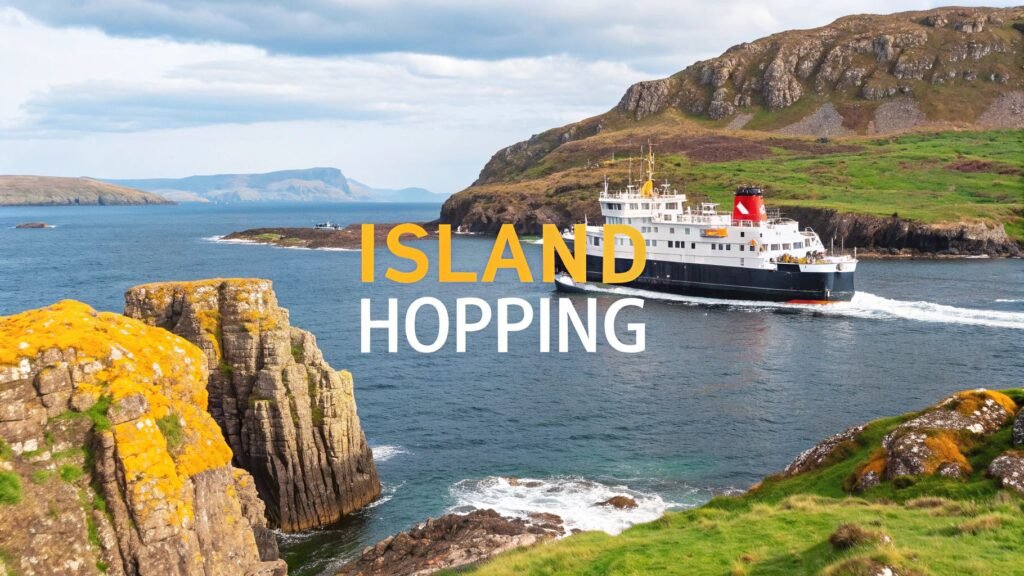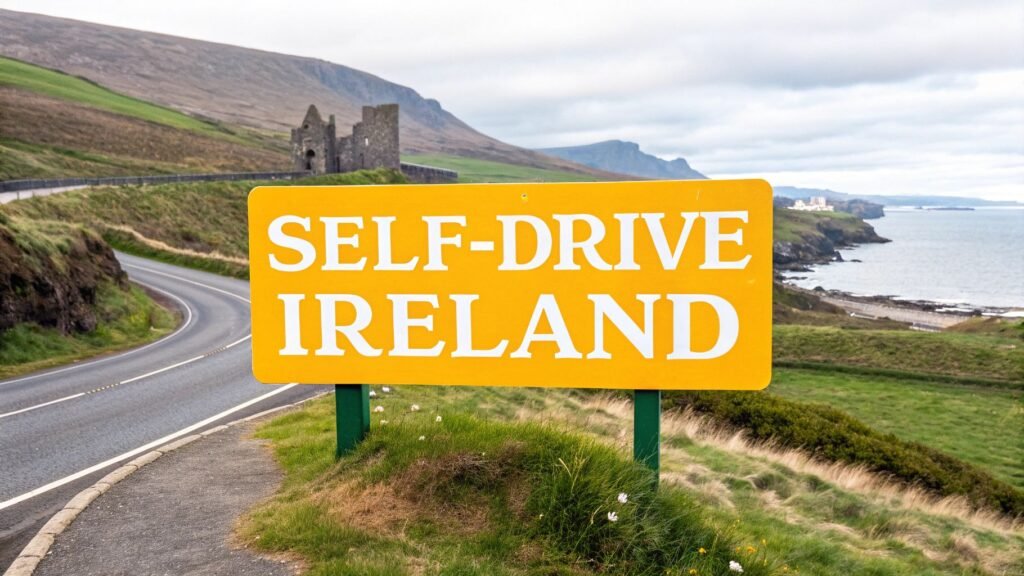Picture this: you’re standing on the deck of a ferry, the Scottish mainland shrinking behind you as you head towards dramatic coastlines, ancient stone circles, and a welcome that’s as warm as the local pub’s fireplace. That’s the very essence of island hopping in Scotland – a proper adventure through archipelagos steeped in history and jaw-dropping natural beauty. This guide is everything you need to make that dream a reality.
Why You Should Go Island Hopping in Scotland
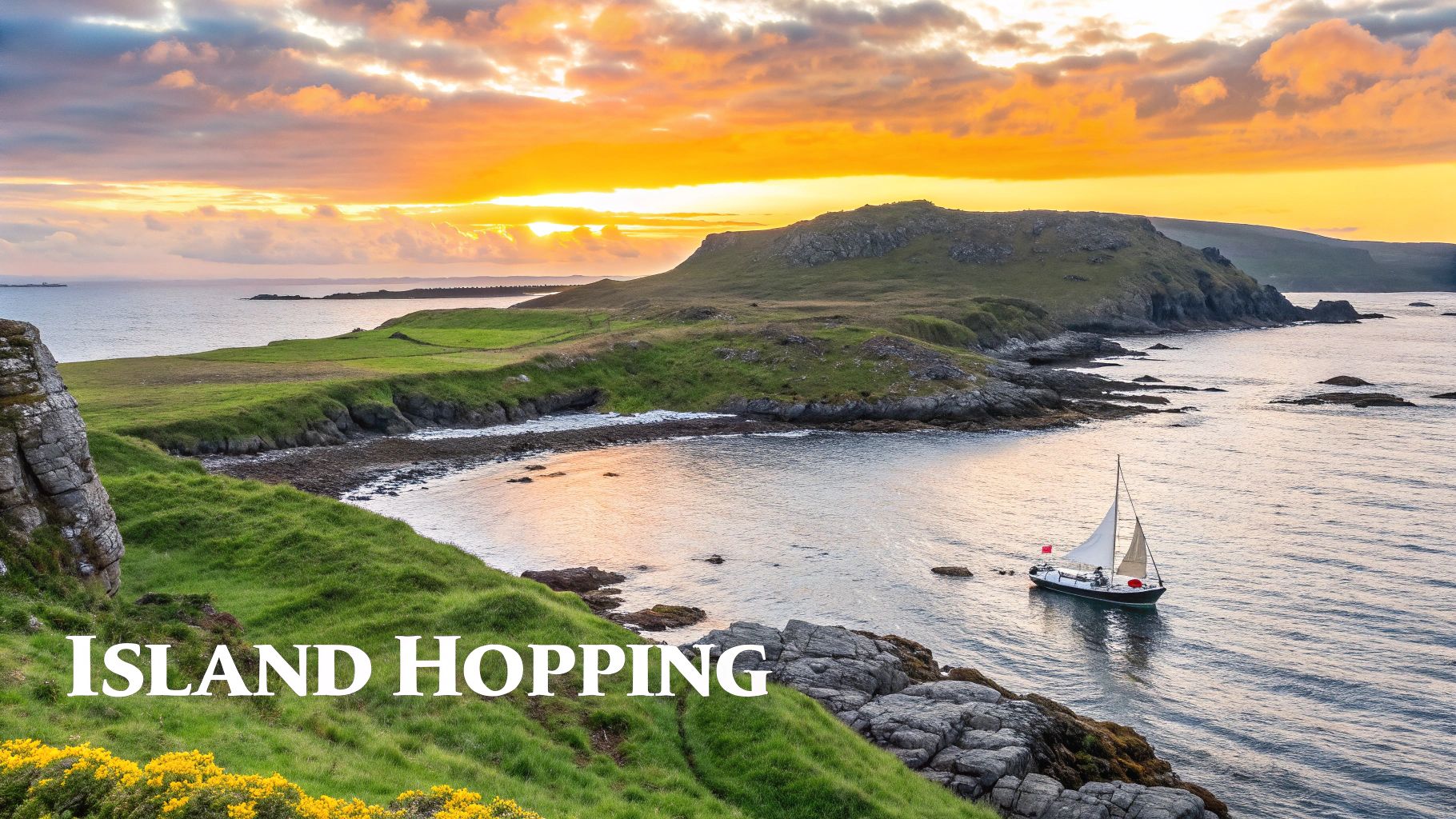
Honestly, a trip to Scotland isn’t quite complete until you’ve experienced its islands. With over 900 offshore islands scattered along its coast, each one offers a unique window into Scottish heritage and landscapes. This isn’t just a holiday; it’s a chance to connect with landscapes carved by the elements and communities shaped by the sea.
Think of it this way: visiting mainland Scotland is like reading a fantastic book, but island hopping is like getting lost in its most compelling chapters. Every ferry journey is like turning a page, revealing a new story, a different accent, and a view that feels a world away from the last.
A Journey of Incredible Variety
The sheer contrast from one island to the next is what makes this kind of trip so special. You could be scrambling over the jagged mountains of Skye one day and strolling along the Caribbean-esque white sands of Harris the next. This amazing diversity means you can craft an itinerary that’s perfectly suited to what you love.
So, what can you expect from an island-hopping adventure?
- Scenery that stops you in your tracks: From towering sea cliffs and rugged peaks to peaceful lochs and vast, empty beaches.
- A deep sense of culture: You'll find yourself in places where Gaelic is still spoken, traditional music sessions are the heart of the local pub, and ancient history is literally written on the land.
- Wildlife everywhere you look: Keep your eyes peeled for puffins, seals, otters, and even the magnificent sea eagle soaring overhead.
- A chance to slow down: Leave the mainland rush behind and sink into the gentle, unhurried rhythm of island life.
A Destination Gaining Worldwide Acclaim
It’s no secret that the Scottish isles are something special, and the rest of the world is catching on. The islands are a huge draw for tourism, attracting around 7% of all domestic tourists in 2024.
Highlighting their growing reputation, the Outer Hebrides were recently named one of National Geographic’s 'Best of the World' destinations for 2025—the only place in the UK to make the list. You can read more about this prestigious recognition and see for yourself what makes these islands so captivating.
How to Choose Your Perfect Island Hopping Route
Picking a path through Scotland's islands is half the fun. With over 900 of them scattered off the coast, each with its own unique feel, the sheer choice can feel a bit overwhelming at first. But don't worry—think of us as your personal guide, here to help you map out the perfect adventure.
A good way to think about the main island groups is to compare them to different types of music. The Hebrides are like a sweeping folk ballad, filled with dramatic landscapes and ancient Gaelic tales. Orkney and Shetland, on the other hand, are powerful Norse sagas, their stories echoing with Viking history and a wild, rugged spirit. Let’s break down the most popular routes to help you find the one that sings to you.
What Kind of Traveller Are You?
Before you start looking at ferry timetables, take a moment to think about what you really want from this trip. Are you dreaming of quiet, windswept beaches where you won’t see another soul? Or are you hoping to find a lively pub session with fiddles playing long into the night?
Maybe your main goal is to walk amongst ancient standing stones, or perhaps spotting puffins and otters is at the top of your list.
Knowing what makes you tick is the key to planning a trip you’ll never forget. A whisky lover, for instance, will feel an undeniable pull towards Islay, while anyone with a passion for archaeology will find Orkney’s Neolithic sites completely captivating. Be honest about your interests, and the right path will quickly become clear.
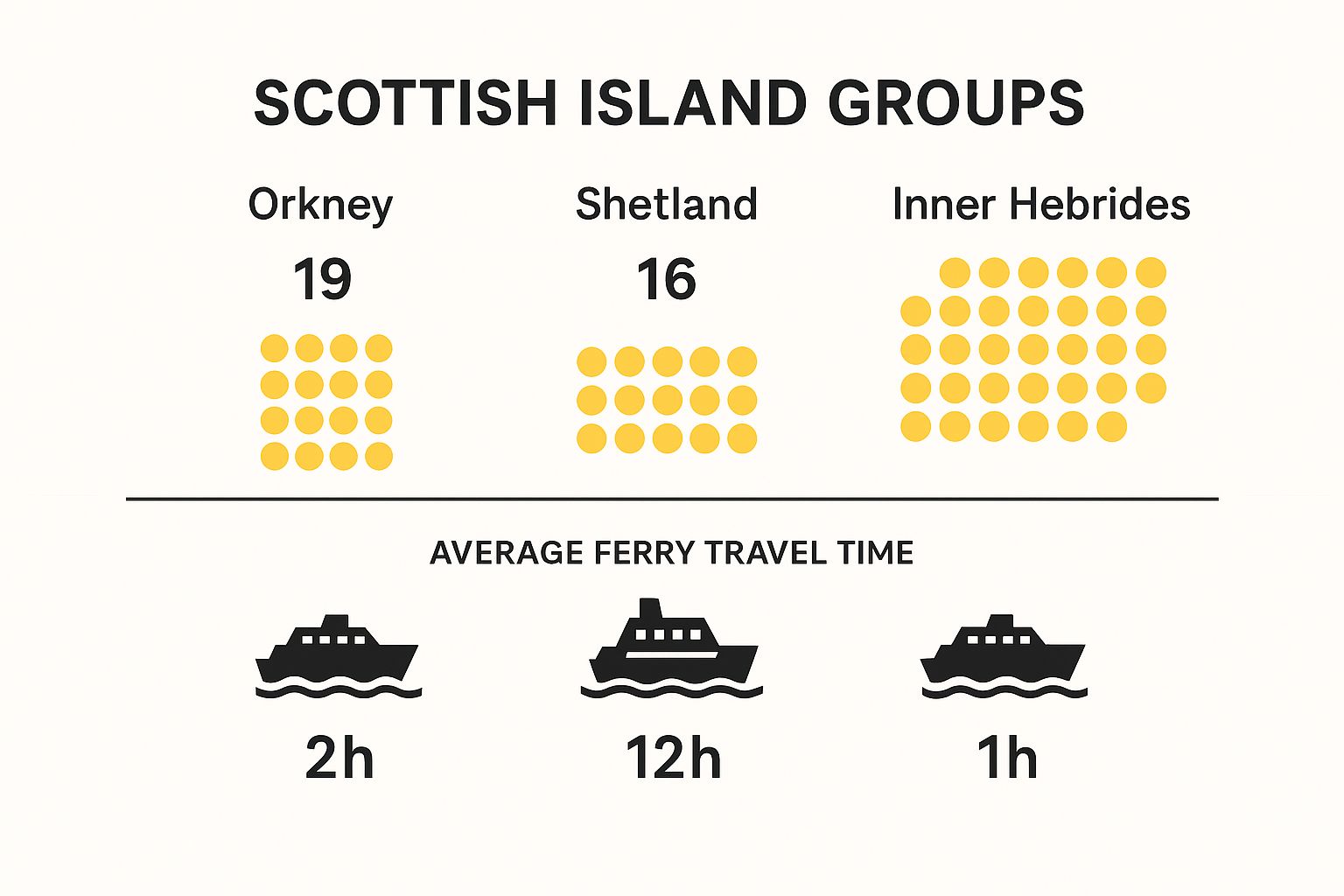
This quick comparison shows that while the Inner Hebrides have the most islands and are easy to hop between, a journey to Shetland requires a much bigger time commitment just for the travel itself.
Comparing Popular Island Hopping Itineraries
To give you a clearer picture, we've outlined three classic routes. Each offers a completely different flavour of Scottish island life, designed for different interests and schedules. The table below gives a quick overview to help you compare them at a glance.
| Route Name | Primary Focus | Suggested Duration | Key Islands |
|---|---|---|---|
| The Hebridean Explorer | Gaelic culture, dramatic landscapes, and a sense of escape | 10-14 days | Skye, Harris, Lewis |
| The Northern Isles Saga | Viking history, Neolithic sites, and unique wildlife | 7-10 days | Orkney Mainland, Shetland |
| A Taste of the Isles | Whisky, charming villages, and accessible nature | 4-6 days | Mull, Iona, Islay |
Each of these journeys has something special to offer, whether you have a full two weeks to get lost in the Outer Hebrides or just a long weekend to sample the delights of the Inner Isles.
Three Classic Island Hopping Routes in Detail
1. The Hebridean Explorer (The Full Works)
This is the classic, quintessential island-hopping experience in Scotland. It’s a proper deep dive that takes you through the stunningly varied landscapes of both the Inner and Outer Hebrides, from jagged mountains to beaches that look like they belong in the Caribbean.
- You’ll love this if you want: Gaelic culture, mind-blowing scenery, and a true sense of getting away from it all.
- How long you’ll need: Give yourself a good 10-14 days so you can really soak it all in without feeling rushed.
- Don't miss: Start on Skye for its famous peaks, then catch a ferry to Harris for the white sands of Luskentyre. From there, head north to Lewis to see the ancient Calanais Standing Stones.
2. The Northern Isles Saga (For the History Buffs)
This route ventures far from the west coast to the truly unique archipelagos of Orkney and Shetland. Life up here has a completely different feel, a fascinating blend of Scottish and Norse heritage. The archaeological sites are simply world-class, some even older than the pyramids.
- You’ll love this if you want: Neolithic and Viking history, dramatic cliff-top walks, and incredible birdlife.
- How long you’ll need: Plan for 7-10 days, keeping in mind the longer ferry journeys to get there.
- Don't miss: Explore Orkney's 'Heart of Neolithic Orkney' UNESCO site, including the incredible prehistoric village of Skara Brae. Then, take the overnight ferry to Shetland to discover its rugged coastline and famous pint-sized ponies.
3. A Taste of the Isles (The Perfect Introduction)
If you're shorter on time or this is your first trip to the Scottish islands, this is the perfect route. It focuses on the easily-reached Inner Hebrides, packing an amazing variety of experiences into a more compact and manageable trip.
- You’ll love this if you want: World-famous whisky distilleries, postcard-perfect fishing villages, and easy-to-access wildlife spotting.
- How long you’ll need: You can see a lot in just 4-6 days.
- Don't miss: Base yourself near Oban and take day trips to Mull for its colourful harbour town of Tobermory and the spiritual Isle of Iona. And of course, you can't miss Islay, the 'Queen of the Hebrides', which is home to an incredible nine world-class whisky distilleries.
Ultimately, there’s no single "best" route. The perfect trip is the one that fits your schedule, your budget, and whatever it is that truly excites you about Scotland.
Whether you choose the Gaelic heartlands of the Hebrides or the Viking soul of the Northern Isles, you're in for an unforgettable adventure. For even more inspiration, check out our comprehensive guides to touring Scotland, which are packed with ideas you can adapt for your own island-hopping journey.
Mastering Your Travel and Transportation Logistics
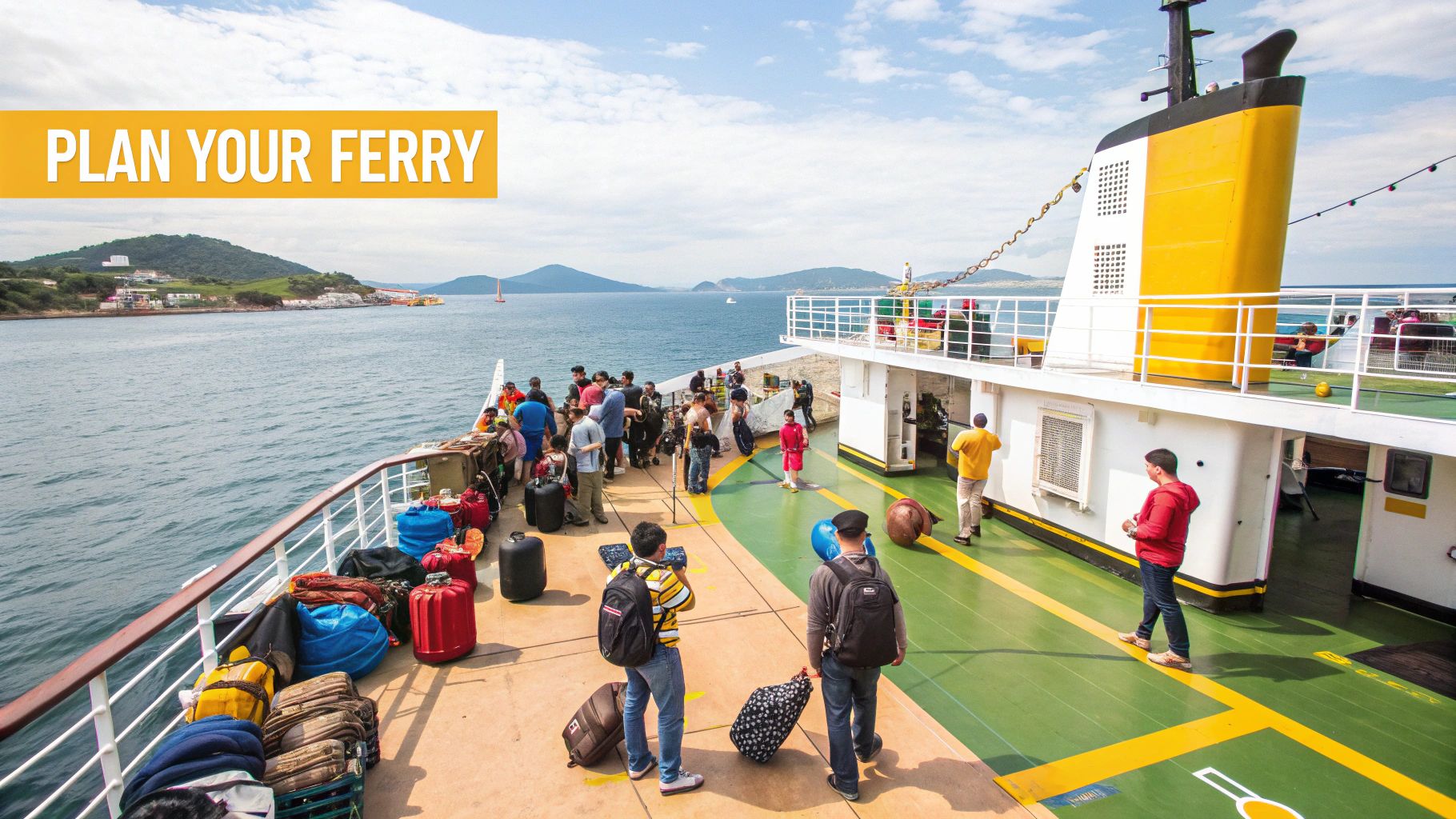
The journey between the islands is a massive part of the adventure itself. Honestly, you should think of the ferries less as simple transport and more as mobile viewing platforms offering some of Scotland’s most breathtaking coastal scenery. Nailing your logistics is the key to a stress-free trip, so let’s get into the details of getting from A to B.
Navigating the waters for your Scottish island hopping trip is much simpler than it looks. The whole network is really run by just two main ferry operators, each covering different parts of the country. Get your head around these two, and you're well on your way.
Your Ferry Lifelines: CalMac and NorthLink
Think of these two companies as the arteries of island travel. For the most part, they are the way to move between the islands, especially if you’re bringing a car along for the ride.
-
CalMac (Caledonian MacBrayne): This is the big one. CalMac operates the huge network of routes crisscrossing the west coast. If your plans involve the Hebrides—from Arran in the south all the way up to Lewis in the north—you’ll be getting very familiar with their blue and white ships. They connect over 20 islands to the mainland and to each other.
-
NorthLink Ferries: Just as the name implies, this operator handles the journeys to the Northern Isles. They run the longer, often overnight, sailings from Aberdeen up to Orkney and Shetland. They also cover the much shorter crossing from Scrabster (near Thurso on the mainland) to Stromness in Orkney.
A crucial piece of advice: book your ferry well in advance, especially during the peak summer months of July and August. This is non-negotiable if you’re taking a car. Vehicle spaces can sell out weeks, sometimes even months, ahead of time. Don't risk leaving it to the last minute.
Unlocking Value with Island Hopper Tickets
One of the smartest ways to arrange your travel is with a multi-journey ticket. CalMac offers a brilliant range of Hopscotch tickets, which are pre-planned routes that bundle several ferry crossings into a single, often discounted, price. It's a bit like buying a rail pass—far simpler and usually cheaper than buying separate tickets for every leg of your journey.
For example, Hopscotch 8 is a classic. It covers the iconic Outer Hebrides route starting from Oban to Barra, then lets you hop north through the Uists and Harris/Lewis before returning to the mainland at Ullapool. One ticket, one simple booking for a whole chain of islands.
These tickets are fantastic for structuring your island hopping Scotland adventure without locking you into a rigid schedule. They take the headache out of booking each crossing and can save you a decent amount of money.
The Car Conundrum: To Bring or Not to Bring?
This is probably one of the biggest questions you'll ask yourself. Do you take your own car? There’s no single right answer; it really comes down to your personal travel style and what you want to get out of the trip.
Pros of Bringing Your Own Car:
- Total Freedom: You can explore every nook and cranny, stop whenever a stunning view appears, and travel entirely on your own clock.
- Convenience: All your luggage and gear just stays in the boot. No lugging heavy bags between B&Bs.
- Access to Remote Areas: So many of the most beautiful spots are miles from any bus route. A car is often the only practical way to see them.
Cons of Bringing Your Own Car:
- Ferry Costs: The price of a ferry ticket shoots up once you add a vehicle.
- Booking Stress: You must book vehicle spots far ahead in summer, which kills a bit of the spontaneity.
- Single-Track Roads: Let's be honest, navigating narrow island roads with passing places can be a white-knuckle experience if you’re not used to it.
If you love the freedom of the open road, take a look at our self-drive tours for some great ideas on how to plan a route with your own car. On the other hand, for those who'd rather let someone else do the driving, relying on local transport is a perfectly good option. Most islands have bus services linking the main villages, and local taxis can always fill in the gaps.
Faster Travel: The Island Flights
For anyone on a tight schedule or just looking for a truly unique travel story, you can also fly. Loganair, Scotland’s airline, operates a handy network connecting Glasgow to key island airports like Stornoway (Lewis), Benbecula (Uists), and Barra.
The views from the plane are absolutely spectacular—a true bird's-eye perspective of the archipelagos. And the flight into Barra is world-famous. It’s the only commercial airport on the planet where planes land right on a tidal beach. It's an unforgettable experience, but be prepared, it does come with a higher price tag than the ferry.
When Should You Go and What Should You Pack?
Getting the timing and your packing list right for a Scottish island-hopping trip is half the battle won. Get it right, and you'll be set for an unforgettable adventure, no matter what the famously fickle weather throws at you.
Every season in the islands has its own unique charm. Deciding when to go really comes down to what you're looking for – are you after long, sunny days and lively festivals, or would you prefer the peace and quiet of the shoulder seasons with their own kind of stark beauty?
A Quick Guide to the Seasons
Thinking about the islands in terms of their seasonal rhythm will help you pinpoint the perfect time for your trip. Life on the isles changes throughout the year, from the buzz of summer ceilidhs to the dramatic, windswept landscapes of winter.
Spring (April – May)
This is, for my money, one of the best times to visit. The days are stretching out, the coastal grasslands (known as the machair) are coming alive with wildflowers, and the islands are shaking off their winter slumber. Best of all? The notorious Scottish midge hasn't arrived yet. This is also when the seabirds return in their thousands, including the iconic puffins who usually start reappearing at their cliff-side burrows in April.
Summer (June – August)
Summer brings the 'simmer dim' – those wonderfully long twilight evenings, especially noticeable the further north you go in Orkney and Shetland. This is peak season. You’ve got the best chance of sunshine, a calendar packed with local festivals, and every visitor attraction is open for business. The trade-off is that it's the busiest and most expensive time. You absolutely have to book your ferries and accommodation well in advance. And yes, this is prime midge season.
The secret is out, and more people are discovering the magic of the islands. Domestic travel here is on the rise, with forecasts showing a +5% net increase in UK holiday intentions for 2025. It's all part of a bigger shift towards shorter, nature-focused breaks – something the islands deliver in spades. You can dig into these travel trends and discover additional insights into Scottish tourism.
Autumn (September – October)
As the summer crowds head home, a wonderful sense of calm settles over the islands. The landscape puts on a spectacular show of rich, autumnal colours, and the low sun makes for some truly breathtaking sunrises and sunsets. It’s a fantastic time for walkers and photographers. If you're lucky, you might even catch the Northern Lights (Aurora Borealis) in the far north from late September.
Your Essential Island-Hopping Kit
If I could give you one piece of packing advice for the Scottish isles, it would be this: layers. The weather can turn on a sixpence, and being able to quickly add or shed a layer is the key to staying comfortable.
The Non-Negotiables for Clothing:
- A Proper Waterproof Jacket & Trousers: Don't skimp on this. A good quality, breathable waterproof outer layer is absolutely essential. Seriously, don't leave home without them.
- Warm Mid-Layers: A couple of fleeces or a lightweight insulated jacket will be your best friend. Multiple thin layers are far more practical than one massive, bulky jumper.
- Sturdy Walking Boots: You'll want something waterproof with a decent grip for tackling everything from coastal paths and ancient ruins to boggy hillsides.
- Comfortable Trousers: Quick-drying walking trousers are perfect. Leave the jeans at home if you can – they get wet, stay wet, and take an age to dry.
And while you're getting your kit together, it’s always a good idea to keep your travel documents safe and dry. Something like a durable leather passport holder can give you that extra bit of peace of mind.
A Few Other Must-Haves:
- Midge Repellent: Travelling between May and September? This is non-negotiable. A good repellent (ask any local, they'll probably recommend Smidge) will save your sanity.
- Binoculars: Invaluable for getting a closer look at puffins on a distant cliff, seals lazing on the rocks, or even a pod of dolphins passing by.
- Reusable Water Bottle: The tap water in Scotland is fantastic, so do your bit for the pristine island environment and help cut down on plastic waste.
- Portable Power Bank: A lifesaver for keeping your phone and camera juiced up, especially if you’re staying somewhere remote where plug sockets might be a rare commodity.
Uncovering the Rich Culture of the Scottish Islands
Of course, the dramatic landscapes are what pull most people to the Scottish islands. But it’s the rich, living culture woven through them that will truly capture your heart and make the trip unforgettable. When you venture beyond the stunning scenery, you connect with an ancient history, a vibrant musical tradition, and an identity forged by the sea.
This is where your journey transforms from a simple holiday into something much deeper. An island hopping Scotland adventure is a chance to step into living history, where Gaelic is still spoken at the local shop and old stories are shared over a pint. It’s about more than just seeing; it’s about understanding what makes these places tick.
Stepping Back in Time: Ancient Wonders
The islands are like open-air museums, scattered with archaeological sites so ancient they make the Egyptian pyramids look recent. The Northern Isles, in particular, are an absolute treasure trove for anyone fascinated by our distant past.
Orkney is home to the 'Heart of Neolithic Orkney', a UNESCO World Heritage site of such staggering importance that it’s often mentioned in the same breath as Stonehenge or the Great Wall of China. It’s an astonishingly well-preserved collection of monuments from over 5,000 years ago.
You can literally walk through the halls of history here. No visit is complete without exploring these key sites:
- Skara Brae (Orkney): Once buried by sand dunes, this prehistoric village offers an incredible glimpse into Neolithic life. You can peer into stone huts and see their built-in beds, dressers, and hearths, imagining a family huddled around the fire thousands of years ago.
- Calanais Standing Stones (Lewis): As you approach this awe-inspiring stone circle, it’s impossible not to feel a sense of wonder. The stones have stood sentinel over the landscape for millennia, their original purpose still a captivating mystery.
- Jarlshof (Shetland): This is one of Scotland's most remarkable archaeological sites, peeling back layers of settlement from the Neolithic and Bronze Ages, right through the Viking era and into medieval times.
The Enduring Spirit of Gaelic Culture
In the Hebrides, you'll find a culture that is distinctly Gaelic. This isn't just a historical footnote; it's the living, breathing soul of the islands. The Gaelic language (Gàidhlig) is deeply entwined with the region's music, stories, and sense of self.
Even if you don't understand the words, you'll feel its presence on road signs, in the names of villages, and in the lyrical lilt of the locals. It represents a resilient heritage that has survived for centuries against all odds.
A Toast to Island Flavours
You can also taste the islands' culture. The pure water, salty air, and rich peat create flavours famous around the world, especially when it comes to whisky. For any whisky lover, Islay, the 'Queen of the Hebrides', is the ultimate pilgrimage, home to an incredible nine world-class distilleries.
Each distillery has its own distinct character, from the intensely smoky, peaty drams of Laphroaig and Ardbeg to the smoother, more nuanced notes of Bruichladdich and Bunnahabhain. A distillery tour is a fantastic way to connect with a local craft that has shaped the island's economy and story for generations. Beyond the dram, the culinary scene is thriving with incredible fresh seafood and local produce. If you're keen to explore, our guide to a self-drive culinary tour of Scotland has plenty of ideas you can weave into your island adventure.
Finding the Heartbeat of Island Music
Finally, no cultural deep-dive is complete without the music. Traditional music is the very heartbeat of the islands, and the best place to find it is in a cosy pub during an informal music session, or 'cèilidh'.
This is where local musicians—and often talented visitors—gather to play fiddles, accordions, and pipes. It’s not a formal performance; it’s a communal celebration of heritage, stories, and friendship. Don’t be shy. Grab a drink, find a seat, and just let the infectious energy of the music wash over you for a truly authentic island experience.
How To Travel Sustainably And Support Local Communities
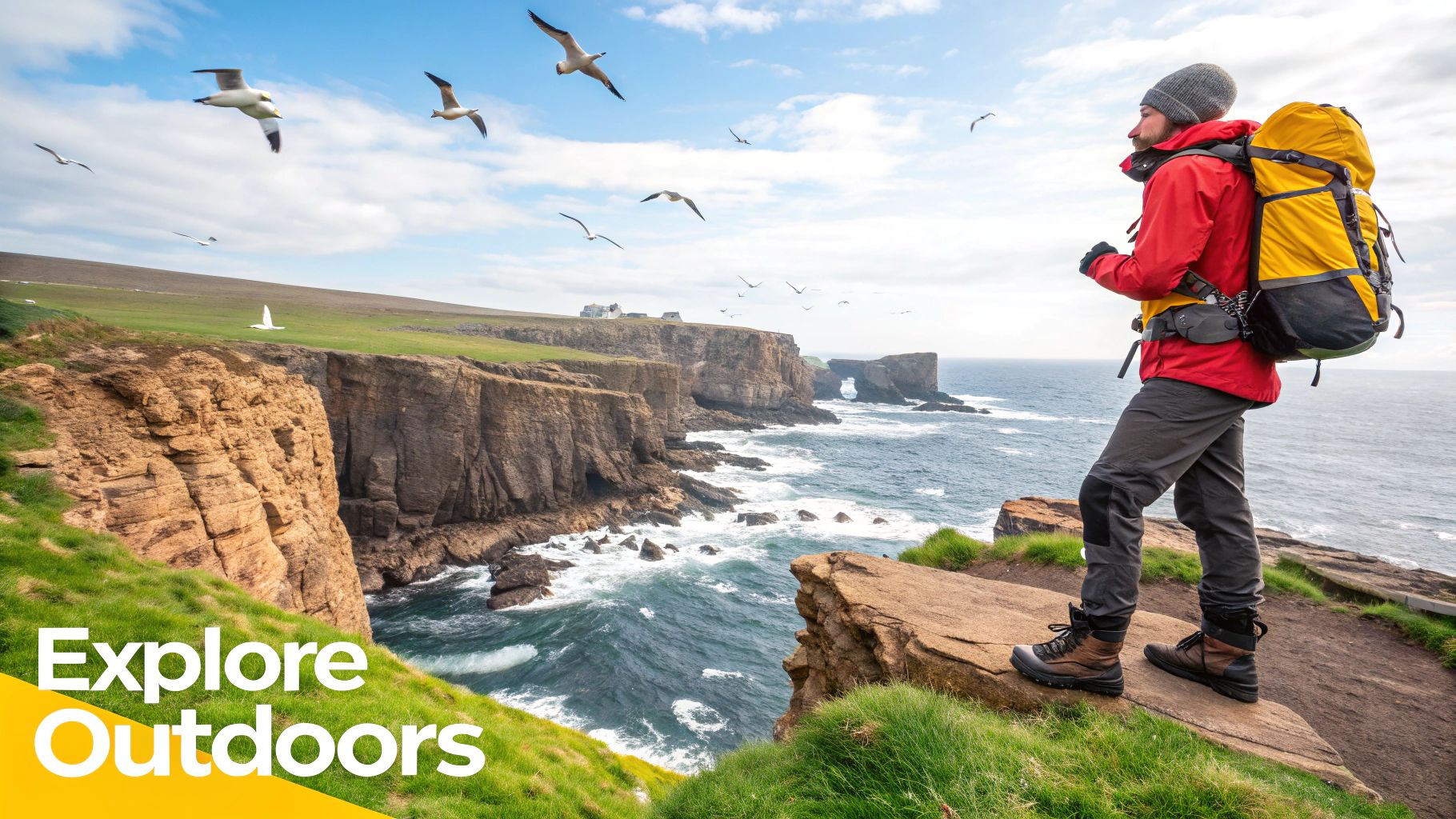
The wild, untamed beauty of the Scottish islands is their greatest treasure, but it’s a fragile one. When you're island hopping in Scotland, you have a fantastic chance to do more than just see these places—you can actively help protect them for years to come. It’s all about making small, thoughtful choices that add up to a huge positive impact.
It's a delicate balance. Tourism is the lifeblood for many of these small island economies, yet the influx of visitors can put a real strain on delicate ecosystems and tight-knit communities. Think about the erosion on popular walking routes or the pressure on local housing—the challenges are very real. The good news is that your visit can be a powerful force for good, as long as you travel with a sense of awareness and respect.
Adopt The Leave No Trace Mindset
The golden rule for exploring Scotland's great outdoors is simple: leave it exactly as you found it. This idea is the heart of the Scottish Outdoor Access Code, which champions responsible enjoyment of the countryside. It’s about so much more than just not dropping litter; it's a whole mindset of minimising your impact.
This means sticking to established paths to prevent erosion, keeping a safe and respectful distance from wildlife (no matter how good the photo op!), and never, ever lighting fires in unauthorised areas. Just think of yourself as a quiet, considerate guest in nature’s home.
"Take nothing but pictures, leave nothing but footprints, kill nothing but time." This old traveller’s creed is the perfect mantra for your island adventure. It perfectly captures the spirit of respect needed to preserve these special places.
Thinking about sustainable transport is also a big part of the picture. For a bit of inspiration on what eco-friendly marine travel can look like, you can read about pioneering emission-free solar boat voyages.
Championing The Local Economy
One of the best ways to support the islands is to put your money where it matters most: right back into the community. When you choose to spend with independent businesses, you're ensuring your travel funds directly benefit the people who call the islands home.
This simple act strengthens the local economy and helps maintain the unique character of each island. Here’s how you can make a real difference:
- Shop Local: Instead of a big supermarket on the mainland, buy your groceries from the village store and pick up souvenirs from local artisans.
- Eat and Drink Local: Make a point of visiting family-run cafés, pubs, and restaurants. You'll get an authentic taste of island hospitality and incredibly fresh produce.
- Stay Local: Opt for independent B&Bs, charming guesthouses, or small, locally owned hotels. This provides vital income for island families.
Scotland's visitor economy is growing, and in 2024, tourism supported a staggering 245,000 jobs across the country. That figure is especially crucial for island communities where tourism is a major economic lifeline. This growth, however, also puts pressure on local infrastructure, making your mindful spending more important than ever.
Your Island-Hopping Questions, Answered
Even the most organised traveller has those last-minute questions that pop into their head. To help you iron out the final details, here are some quick answers to the things people most often ask about island hopping in Scotland.
Think of this as your final pre-trip briefing. We’ll cover everything from money matters and booking essentials to wildlife and Wi-Fi, making sure you feel completely ready for the adventure ahead.
How Much Should I Budget for My Trip?
This is a tricky one, as costs can vary hugely depending on your travel style. As a rough guide, I'd suggest planning for around £100-£150 per person, per day. This should comfortably cover a nice B&B, meals, and your ferry crossings.
Of course, your final spend depends on your choices:
- Accommodation: A good quality double room in a B&B or guesthouse will likely set you back £80-£120 a night.
- Food: You can eat really well by sticking to local pubs and cafés. If you do, a daily food budget of £40-£50 is realistic.
- Transport: Ferries are a significant part of the budget, especially with a car. A multi-island journey can easily add a few hundred pounds to your total, so be sure to price this up properly.
Do I Really Need to Book Everything in Advance?
In a word: yes. The romantic idea of a spontaneous, turn-up-and-go trip just doesn't work for the Scottish islands, especially during the peak season from May to September. Accommodation is surprisingly limited, and the best places get snapped up months—sometimes even a year—ahead.
The same rule applies to ferries if you’re taking a car. Vehicle spaces on popular routes, like the main arteries through the Outer Hebrides or the crossing to Skye, are like gold dust. To avoid being left on the pier, I always tell people to book at least two to three months in advance.
What Are the Best Islands for Spotting Wildlife?
The islands are an absolute paradise for wildlife lovers. If you have your heart set on seeing something specific, some islands are better bets than others.
- Puffins: For those iconic seabirds, you can't beat a boat trip to Lunga from the Isle of Mull. Shetland is another world-class hotspot. The season runs from April to early August.
- Seals & Otters: You have a great chance of seeing both common and grey seals all over the place, but Skye and the Outer Hebrides are fantastic. For the much shyer otter, scan the coastlines at dawn or dusk.
- Eagles: Mull has a reputation for a reason. It’s one of the best places in the UK to spot both magnificent golden eagles and the even larger white-tailed sea eagles.
What’s the Mobile Phone and Internet Situation?
It’s best to prepare for a bit of a digital detox. In the main towns like Portree on Skye or Stornoway on Lewis, you’ll find a decent mobile signal and Wi-Fi. But as soon as you head into the more remote glens and coastlines, coverage can get patchy or disappear entirely.
A word of advice from experience: don't rely solely on your phone's GPS for navigation. Download your maps for offline use before you go, or better yet, carry a good old-fashioned physical map as a foolproof backup. Most B&Bs and hotels offer Wi-Fi, but don't be surprised if it’s a bit slower than you’re used to back home.
Ready to stop dreaming and start planning your unforgettable Scottish island adventure? At BTOURS, we specialise in creating personalised self-drive tours that let you explore the magic of Scotland at your own pace. Discover our expertly crafted itineraries and begin your journey today at https://www.btours.com.

